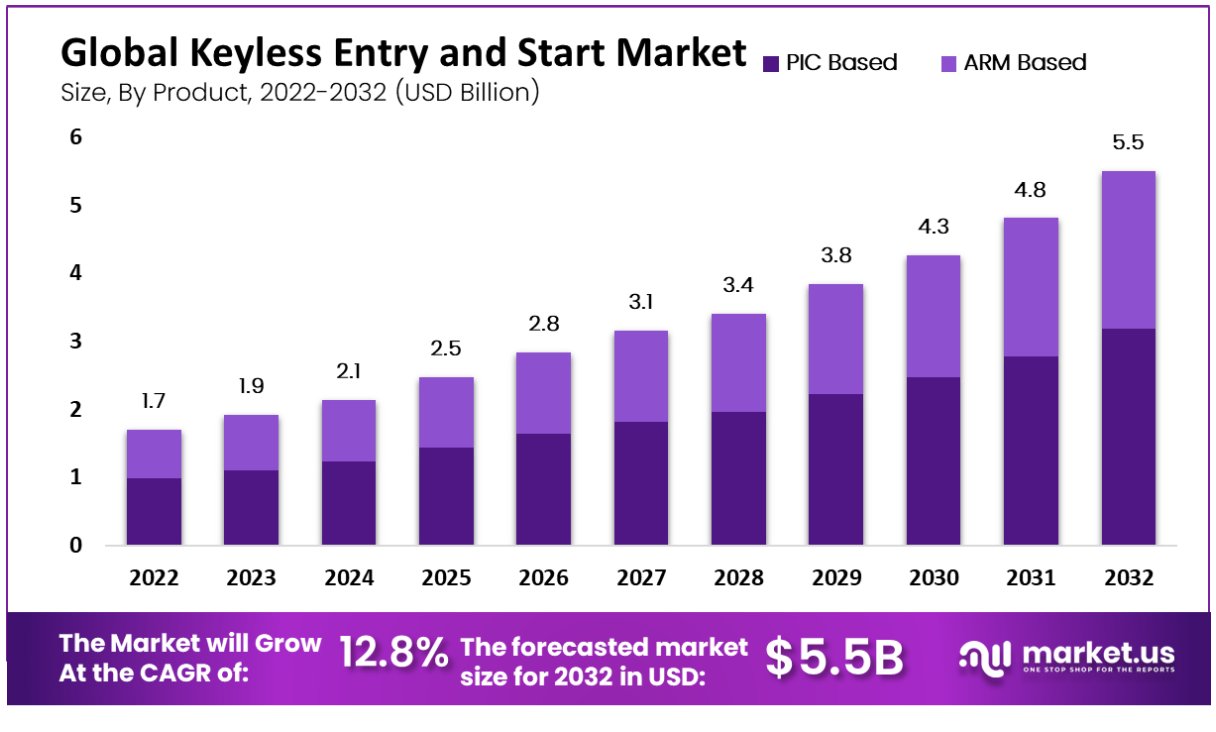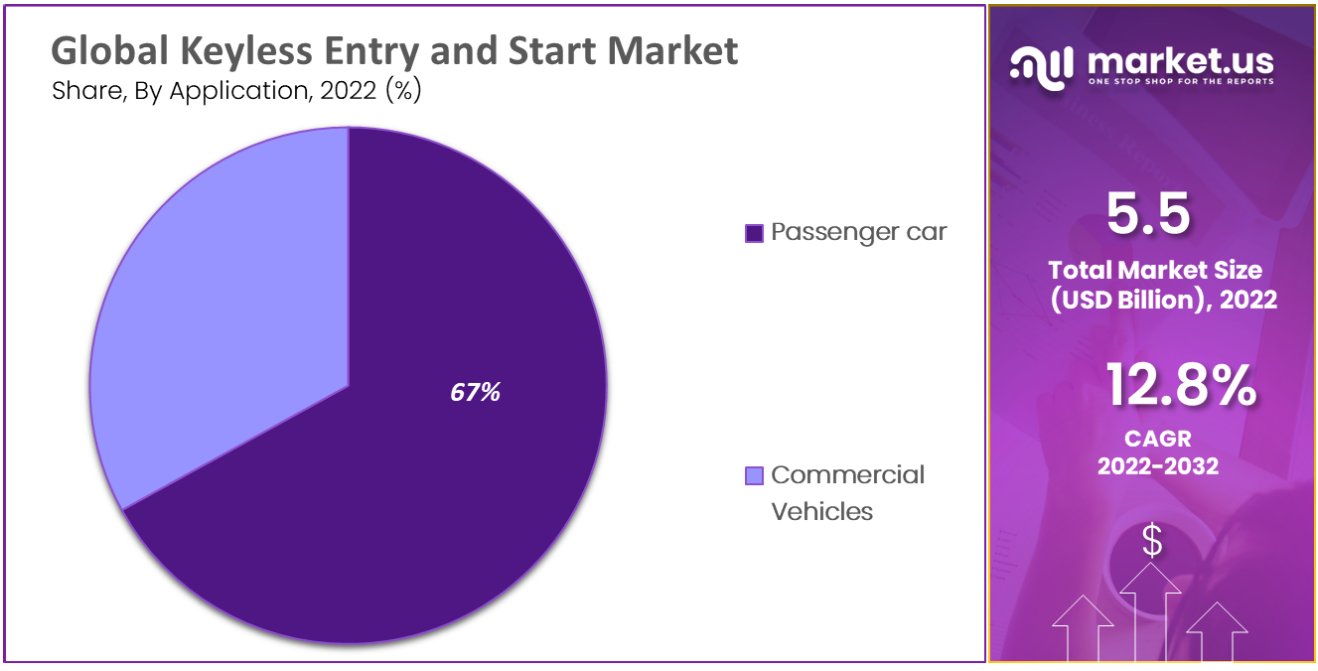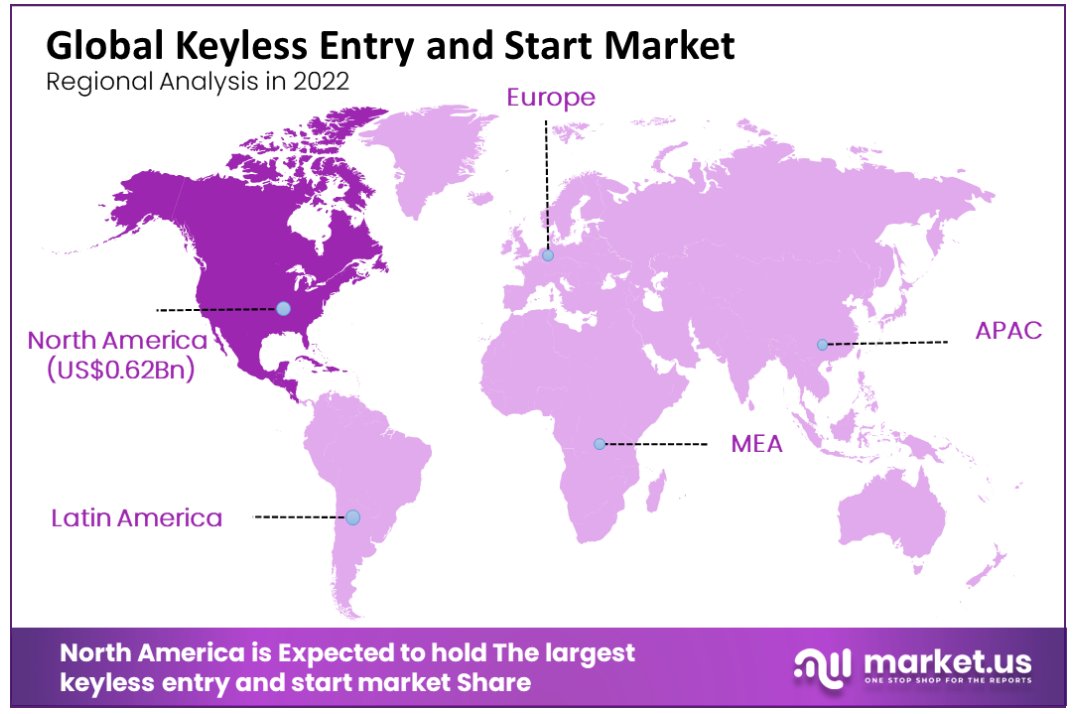Global Keyless Entry and Start Market, By Product Types (PIC Based and ARM Based), By Application, By Region and Companies - Industry Segment Outlook, Market Assessment, Competition Scenario, Trends, and Forecast 2023-2032
- Published date: Sep 2023
- Report ID: 100122
- Number of Pages: 281
- Format:
- keyboard_arrow_up
Quick Navigation
Report Overview
The Global Keyless Entry and Start Market size is expected to be worth around USD 5.50 Billion by 2032 from USD 1.7 Billion in 2022, growing at a CAGR of 12.8% during the forecast period from 2023 to 2032.
Keyless access systems are electronic locks that allow the owner of the car to unlock the vehicle and start the vehicle without the need for a conventional mechanical key. The car’s keyless access system uses biometric scanning and electronic locks to unlock it.
This secures the vehicle. The keyless access market is expanding rapidly in the US and Germany. As one of the essential components in modern vehicles for increased safety, automotive keyless entry systems are directly influenced by the manufacturing and sales activities of automobiles globally.

Driving Factors
Convenience: By reducing the need to physically insert and turn the key to start the car or unlock the doors, keyless entry systems provide a high level of convenience for drivers. This can be especially useful when the driver needs to rapidly access the car.
Security: As keyless entry systems usually include encryption and other security features to avoid undesirable access, they may also give an extra degree of protection to cars. This can reduce the probability of break-ins and prevent thefts.
Technical developments: More complex keyless entry systems have been made possible by the advent of new technologies including biometric authentication and sophisticated encryption techniques. These solutions provide more convenience and security. These factors can drive the growth of the market in the projected time.
Restraining Factors
Cost: The installation and maintenance of keyless entry systems can be pricey, which may dissuade some customers from buying automobiles with these features. Also, it might be expensive to fix or replace a broken keyless entry system. This can hamper the market growth.
Cybersecurity concerns: Keyless entry systems are becoming increasingly sophisticated, which raises worries about cybersecurity threats including hacking and remote access assaults. This may reduce customer trust in these systems and hinder market expansion.
Problems with compatibility: Keyless entry systems may not work properly or may need additional parts or modifications in some types of automobiles. Because of this, it could be challenging for manufacturers to integrate these technologies into their cars, which might restrict market expansion.
Growth Opportunities
Integration with other car systems: To provide a smooth and easy experience of driving, keyless entry systems may be connected with other vehicle systems including infotainment and map-reading. As the sales of passenger vehicles increasing day by day this provides great opportunities to the companies operating in this market.
Increasing demand for EVs: Demand for keyless entry systems that can connect with the special features and capabilities of electric vehicles, and the demand for keyless entry systems increase as demand for these vehicles rises. This may open up new markets for keyless entry system innovation and differentiation.
Biometric authentication technological advancements: It could be practicable to integrate various other applications such as front & rear seat settings, opening the tailgate, car alarm, light control, and storing multimedia files into keyless entry systems as keyless entry technologies continue to advance. Customers may experience a greater degree of security and convenience as a result, and new potential for market expansion and uniqueness may also develop.
Latest Trends
Smartphone app integration: Several companies are now connecting their keyless entry systems with applications for smartphones, enabling users to unlock and start their cars using their phones. As more customers rely on their cell phones for daily chores, this tendency is anticipated to continue.
Expansion of remote capabilities: An increase in remote capabilities has led to the availability of several keyless entry systems, which enable users to operate numerous car functions from a smartphone or other device. As customers want more control and convenience, this trend is anticipated to continue in near future.
By Product Type Analysis
Based on product type the market is divided into PIC-based and ARM-based segments depending on product types. The ARM-based market is utilized in high-end luxury automobiles owing to its high processing capacity and security, but the PIC-based market is cost-effective and usually utilized in entry-level vehicles.
By Application Analysis
The market for automotive keyless entry systems is divided into two categories based on the application; passenger cars and commercial vehicles. The majority of the market share is held by and is anticipated to continue to be led by the passenger cars in the applications segment. This is a consequence of increasing passenger car sales and the growing adoption of automotive security systems.

Key Market Segments:
Based on Product
- PIC Based
- ARM-Based
Based on Application
- Passenger car
- Commercial Vehicles
COVID-19 Impact Analysis
Keyless entry systems have had both positive and negative impacts as a result of the COVID-19 pandemic. Positively, as people look for more sanitary and frictionless solutions, the pandemic has accelerated the adoption of electronic and connected automobiles. This has led to an increase in the popularity of keyless entry systems, which provide a convenient and touchless way to unlock and start vehicles. The market demand for keyless entry systems has increased after the pandemic.
However, the pandemic has also affected international supply chains and slowed down manufacturing, which has resulted in a shortage of essential parts needed for keyless entry systems which raised prices for manufacturers. Due to manufacturers’ struggles to meet demand and preserve profitability, the market for keyless entry systems has been under pressure.
Regional Analysis
North America is dominant in the global keyless entry and starts market with the largest market share of 36.5%, which is driven by the region’s expanding use of cutting-edge automotive technology and rising consumer demands for security and ease of use. The market for keyless entry and start systems is anticipated to expand at a fast rate in the Asia-Pacific region, driven by rising demand for automotive in the region, the use of advanced technology in the automobile industry, and customers’ demand for more security in their vehicles.

Key Regions and Countries Covered in this Report:
- North America
- The US
- Canada
- Mexico
- Western Europe
- Germany
- France
- The UK
- Spain
- Italy
- Portugal
- Ireland
- Austria
- Switzerland
- Benelux
- Nordic
- Rest of Western Europe
- Eastern Europe
- Russia
- Poland
- The Czech Republic
- Greece
- Rest of Eastern Europe
- APAC
- China
- Japan
- South Korea
- India
- Australia & New Zealand
- Indonesia
- Malaysia
- Philippines
- Singapore
- Thailand
- Vietnam
- Rest of APAC
- Latin America
- Brazil
- Colombia
- Chile
- Argentina
- Costa Rica
- Rest of Latin America
- Middle East & Africa
- Algeria
- Egypt
- Israel
- Kuwait
- Nigeria
- Saudi Arabia
- South Africa
- Turkey
- United Arab Emirates
- Rest of MEA
The market for keyless entry is anticipated to expand more over the coming year as a result of rising customer demand for advanced automotive technology and the increasing acceptance of smart key systems at large.
There are several competitors in the highly competitive keyless entry and start sector, including both established automakers and newcomers. Keyless entry and start systems are primarily supplied by Continental AG, which has a share of the market of around 25%. Passive entry systems and smart keys are among the keyless entry and start the market.
Market Key Players:
- Alps Electric Co. Ltd.
- Continental AG
- DENSO Corporation
- Hella KGaA Hueck & Co.
- Microchip Technology Inc.
- Mitsubishi Electric Corporation
- NXP Semiconductors
- Rebert Bosch GmbH
- Tokai Rika
- Valeo
- ZF Friedrichshafen AG
- Other Key Players
Recent Developments:
Rising adoption by automakers: Keyless entry and start systems are increasingly being offered by automakers as standard or extra equipment on their vehicles. As more customers desire these systems’ ease and security, this trend is anticipated to continue.
Integration with smartphone apps: Certain keyless entry and start systems are now controllable via smartphone apps, enabling drivers to remotely unlock and start their vehicles. For automobile sharing or rental businesses, this functionality is very beneficial.
Improved security features: Keyless entry and start systems increasingly include sophisticated security features like biometric authentication and encryption to address worries about auto theft.
Report Scope:
Report Features Description Market Value (2022) USD 1.7Bn Forecast Revenue (2032) USD 5.5 Bn CAGR (2023-2032) 12.8% Base Year for Estimation 2022 Historic Period 2016-2022 Forecast Period 2023-2032 Report Coverage Revenue Forecast, Market Dynamics, COVID-19 Impact, Competitive Landscape, Recent Developments Segments Covered By Product Type, By Application. Regional Analysis North America – The US, Canada, & Mexico; Western Europe – Germany, France, The UK, Spain, Italy, Portugal, Ireland, Austria, Switzerland, Benelux, Nordic, & Rest of Western Europe; Eastern Europe – Russia, Poland, The Czech Republic, Greece, & Rest of Eastern Europe; APAC – China, Japan, South Korea, India, Australia & New Zealand, Indonesia, Malaysia, Philippines, Singapore, Thailand, Vietnam, & Rest of APAC; Latin America – Brazil, Colombia, Chile, Argentina, Costa Rica, & Rest of Latin America; the Middle East & Africa – Algeria, Egypt, Israel, Kuwait, Nigeria, Saudi Arabia, South Africa, Turkey, United Arab Emirates, & Rest of MEA Competitive Landscape Alps Electric Co. Ltd., Continental AG, DENSO Corporation, Hella KGaA Hueck & Co., Microchip Technology Inc., Mitsubishi Electric Corporation, NXP Semiconductors, Rebert Bosch GmbH, Tokai Rika, Valeo, ZF Friedrichshafen AG, Other Key Players. Customization Scope Customization for segments, region/country-level will be provided. Moreover, additional customization can be done based on the requirements. Purchase Options We have three licenses to opt for Single User License, Multi-User License (Up to 5 Users), Corporate Use License (Unlimited User and Printable PDF) Frequently Asked Questions (FAQ)
What is the Keyless Entry and Start Market Size in the Year 2022?The Global Keyless Entry and Start Market size was USD 1.7 Billion in 2022, growing at a CAGR of 12.8%.
What is the Keyless Entry and Start Market CAGR Estimated During the Forecast Period 2023-2032?The Global Keyless Entry and Start Market size is expected to grow at a CAGR of 12.8% during the forecast period from 2023 to 2032.
What is the Keyless Entry and Start Market Size Estimated During the Forecast Period 2023-2032?The Global Keyless Entry and Start Market size is expected to be worth around USD 5.50 Billion by 2032 during the forecast period.
 Keyless Entry and Start MarketPublished date: Sep 2023add_shopping_cartBuy Now get_appDownload Sample
Keyless Entry and Start MarketPublished date: Sep 2023add_shopping_cartBuy Now get_appDownload Sample - Alps Electric Co. Ltd.
- Continental AG
- DENSO Corporation
- Hella KGaA Hueck & Co.
- Microchip Technology Inc. Company Profile
- Mitsubishi Electric Corporation Company Profile
- NXP Semiconductors
- Rebert Bosch GmbH
- Tokai Rika
- Valeo
- ZF Friedrichshafen AG
- Other Key Players
- settingsSettings
Our Clients
| Single User $4,599 $3,499 USD / per unit save 24% | Multi User $5,999 $4,299 USD / per unit save 28% | Corporate User $7,299 $4,999 USD / per unit save 32% | |
|---|---|---|---|
| e-Access | |||
| Report Library Access | |||
| Data Set (Excel) | |||
| Company Profile Library Access | |||
| Interactive Dashboard | |||
| Free Custumization | No | up to 10 hrs work | up to 30 hrs work |
| Accessibility | 1 User | 2-5 User | Unlimited |
| Analyst Support | up to 20 hrs | up to 40 hrs | up to 50 hrs |
| Benefit | Up to 20% off on next purchase | Up to 25% off on next purchase | Up to 30% off on next purchase |
| Buy Now ($ 3,499) | Buy Now ($ 4,299) | Buy Now ($ 4,999) |












